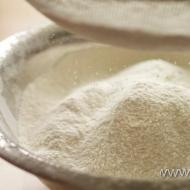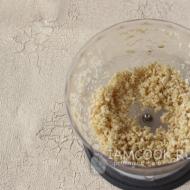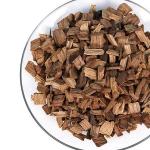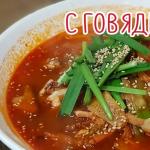
What effect does Georgian green tea have? Georgian tiled tea, production and impressions. Rise and decline
In 1854, during the Crimean War, a British warship was wrecked near the city of Poti. The crew were captured, but according to the noble customs of the times, the officers were housed in the homes of the local nobility - more as guests than as prisoners.
One of them, the Scotsman Jacob McNamarra, fell in love with the daughter of Prince Eristavi, who showed him hospitality: the fifteen-year-old Princess Sofiko. The girl reciprocated his feelings. Their love was so strong that Prince Eristavi could not refuse the foreigner who asked for his daughter’s hand in marriage. Only he set a condition: Sofiko would not go anywhere. If the Scot wants to be with her, let him give up his homeland... Jacob McNamarra remained in Georgia.

But he could not live without tea and therefore was forced to spend a fortune on the delivery of this precious drink. It was then that he decided to try to plant his own tea plantation. Prince Eristavi supported his son-in-law.
Jacob ordered tea seeds not from resellers, but from his old friends from the British Navy. He had to wait a long time, but in the end, living seeds, not spoiled by the greedy Chinese, ended up in his hands, were planted in fertile Georgian soil in the Ozurgeti region, and sprouted.

Already in 1864, the first samples of “Caucasian tea” were demonstrated at an industrial exhibition in St. Petersburg.
From the book “Our Georgian Tea” by Mikheil Davitashvili...
“In the estate of the Georgian prince Mikha Eristavi in the village of Gora-Berezhouli, commotion reigned in the morning: the owner was leaving on a long journey to St. Petersburg. As soon as dawn broke, a carriage drawn by a train was pulled up to the house. The servants began to carry out and tie up the chests.
In the sixties of the last century, the trip of a Transcaucasian resident to Russia was a great event for him and his whole family. But it had a very special meaning for the prince himself. He had to pass a serious exam. He brought to the capital the fruits of his many years of labor - the first samples of Georgian tea.

The whole family put a lot of effort into making this tea. From the time Mikha Eristavi founded the first tea plantation in Georgia, he made everyone in his household ardent supporters of tea growing. When peasant girls began to collect shoots from the bushes, the princely house turned into a tea factory...
Eristavi had instructions translated into Georgian on how to process tea leaves. Trying not to deviate in any way from the precious document, the prince’s wife, sons and daughters, led by himself, performed mysterious manipulations, withering, twisting and drying tea leaves. The tea, according to the household, turned out excellent... Everyone rejoiced.
Eristavi intended to create a large subtropical economy, but his own funds were not enough for this. In 1860, he asked the tsarist government for a loan of 20 thousand rubles. The answer was given four years later, when his plantation had already produced a harvest and samples of dry tea had been made, and it said: “Refuse.” The Kutaisi civil governor, in a report on this issue, thoughtfully stated that the “development of tea trees” in Georgia is “an impracticable matter”; that, perhaps, only in greenhouses, “under artificial conditions”... etc.

And here is Eristavi in St. Petersburg. He has in his hands material proof that it is possible to produce tea in Georgia. In 1864, at the All-Russian Agricultural Exhibition in St. Petersburg, thanks to the efforts of an enthusiast, the first domestic tea appeared. But praise is praise, help... Mikha Eristavi returned to his estate with nothing. That same year he made another attempt to bring his work to the attention of the government. At the end of the year, he presented samples of tea from the harvests of 1862, 1863 and 1864 to the Caucasian Society of Agriculture. The examination approved the tea of 1863. But Caucasian society did not live up to Eristavi’s hopes. As Georgy Tsereteli noted in those years, it “was divorced from the life of the country; members of society were engaged not in serving common interests, but in personal affairs.”

To be fair, it must be added that these first samples of Georgian tea were imperfect; but the essence of the matter is that neither our first tea grower nor the Caucasian society itself received any support from the tsarist government. In 1870, Eristavi died, and tea production experiments virtually ceased for fifteen years. They were resumed in 1885 by the great Russian chemist A.M. Butlerov. He made pretty good tea from the leaves of the tea bushes of the Sukhumi Botanical Garden. He also had his own tea plot between Sukhumi and New Athos. But Butlerov also died before completing these experiments.

However, the idea of domestic tea growing did not die out; it was propagated at different times by Russian scientists: Dokuchaev, Voeikov, Krasnov, Williams, and was picked up by the Georgian public. Prominent public figure Niko Nikoladze, writer and publicist Georgy Tsereteli and many others passionately advocated for the development of tea culture. Nikoladze planted tea seedlings in the Poti Garden and in his native village of Didi-Dzhikhaishi. The outstanding writer and public figure Ilya Chavchavadze wrote in the Iveria newspaper in 1887: “Transcaucasia, thanks to its rich climate and soil, can produce almost everything that grows on the earth and is beneficial. Our region has even grown the cinchona tree and tea bush so successfully that now the government itself is trying to ensure the prosperity and spread of both one and the other culture.”

Tea plantations are located near Chakvi, Ozurgeti, Kabuletti
The tsarist government “tried more than moderately for the prosperity and spread” of tea. More than once, high authorities with the rank of minister or governor refused to allocate land plots for tea plantations to individuals and communities, and the business they started collapsed and the initiative faded. When the Caucasian Society of Agriculture asked for permission to send its trainee on an expedition to the tea countries, an official of the Ministry of State Property refused, presenting a “full-fledged” reason: “the trainee could die there...” Tea traders, who raked in huge profits, were also enemies of domestic tea. There were cases when, on the initiative of Russian scientists, tea seeds and seedlings were purchased in China, Japan and India, delivered to Georgia, planted in the ground, but did not produce good seedlings or normal bushes; checks revealed that they were deliberately damaged. Most often, the seeds lost their viability during the long journey, and sometimes they were sown in unsuitable soils; young bushes died from frost or inept care.

And yet time took its toll. In the late 19th and early 20th centuries, some landowners, wealthy people, and sometimes peasants (rarely local residents, more often immigrants) began to grow tea.
It took many years and the efforts of many people for a highly organized tea industry to be created in Georgia in the first half of the 20th century, and tea to receive the well-deserved right of industrial culture, i.e. tea growing has become the pride of the country's agriculture. Through the efforts of many enthusiasts, work on the selection, cultivation and processing of tea continued, and by the beginning of the 20th century, tea was already being harvested in full swing in Georgia, and several tea factories were operating. The varieties “Bogatyr”, “Kara-Dere”, “Zedoban”, “Ozurgetsky” produced before the revolution were of very high quality. One of the best was considered “Dyadyushkin’s Russian tea” - black tea with a content of tips (tea buds) of up to 5.5%. This variety received a gold medal at the Paris Exhibition in 1900.
1917... The young Soviet republic, having lost ties with many traditional tea exporters, and facing the threat of being left without an essential product, urgently took steps to develop tea growing in Georgia, and then in Azerbaijan and the Krasnodar Territory.

The successes in growing tea in the GSSR were impressive. State policy and support for state farms allowed the Soviet Union, already during the first five-year plans, to abandon the import of tea seeds and significantly reduce the import of tea from abroad. Tea growing has become the pride of socialist agriculture in Georgia, its leading industry. The All-Union Research Institute of Tea and Subtropical Crops and the All-Union Research Institute of the Tea Industry operated in Georgia. The Georgian Agricultural Institute and a number of other scientific institutions were also involved in “tea issues”.

In 1948, Ksenia Bakhtadze was the first in the world to develop artificial tea hybrids: the “Gruzinsky No. 1” and “Gruzinsky No. 2” varieties. Subsequently, breeding work continued, and high-quality varieties of tea were developed, with unique vitality. For example, the hybrid “Georgian selection No. 8” withstood winter temperatures down to -25 °C.
 Tea packaging factory on a tea plantation near Batumi, ca. 1909-1915
Tea packaging factory on a tea plantation near Batumi, ca. 1909-1915
However, hand-picking high-quality tea leaves is very hard work. In order to collect the daily norm (15 kg of leaves), the picker had to make about 36 thousand tears of suitable flushes with her fingers (usually three leaves with buds or 4-5 leaves).
Therefore, there was an urgent need to create and introduce comprehensive mechanization into tea growing as quickly as possible.Therefore, there was an urgent need to create and introduce comprehensive mechanization into tea growing as quickly as possible.

But only after the end of the Second World War, the world’s first comb-pneumatic tea picking machine for selective collection of varietal tea leaves, “Sakartvelo”, was created in Georgia, put into production in 1962. The achievements of the tea industry convincingly prove that in the last century tea became an integral component of the Georgian economy. Moreover, by the end of the 70s, Georgia ranked among the main producers in the production of black long leaf and slab tea (naturally, after India, China and Sri Lanka).

Tea picking machines "Sakartvelo" on the plantation of the Ingirsky state farm.
By the end of the 1970s, Georgia produced 95 thousand tons of ready-made tea per year. Georgian tea was exported to Poland, the German Democratic Republic, Hungary, Romania, Finland, Czechoslovakia, Bulgaria, Yugoslavia, Afghanistan, Iran, Syria, South Yemen, and Mongolia. In Georgia, black long tea, green leaf tea, tile tea, and brick tea were produced. Black tea was consumed by the European republics of the USSR and European countries, green tea was consumed by Kazakhstan, Turkmenistan, Uzbekistan, and the countries of Central Asia.


Set “Soviet assorted tea” 1939.

"Amateur with a flower." Top grade. NARKOPISCHEPROM.
First grade. Tea-packing factory named after. Lenin. MOSSORSOVNARKHOZ.
First grade. Tea-packing factory named after. Mikoyan, Odessa. MPPT USSR. GOST 1938-46
Recession. In the 1970s, along with an increase in the volume of Georgian tea production, a progressive decline in its quality was noted. The transition from manual collection of tea leaves to mechanical one led to a sharp deterioration in the quality of the raw materials. The race for performance has led to widespread violation of technology - from allowing tea to be harvested in wet weather, to speeding up the processing of tea leaves by eliminating the mandatory drying stage. After the collapse of the USSR, Russia, due to the low quality of Georgian tea, reoriented itself to the supply of imported varieties. Georgian tea production was practically abandoned and, despite the emergence of companies producing competitive products, has not yet regained its former position.

After the collapse of the USSR, the leadership of independent Georgia set a course to curtail tea production and destroy plantations under the pretext that tea was an alien product for Georgia. International statistics noted that in 1993 production practically stopped altogether. The war, especially in Abkhazia, severed economic ties and created chaos in production.
Today Georgian tea production is experiencing a deep decline. The total area of tea plantations is 50 thousand hectares.
Hundreds of thousands of specialists from tea farms and factories, machine operators, and tea pickers were left without work. Many women were forced to find work in the tea plantations of Turkey. And the tea plantations of Georgia... a tea bush in free development grows into a tea tree and loses its main purpose - to produce industrial tea leaves. Moreover, restoring a badly neglected plantation requires expensive manual labor. Therefore, there is no way to allow the irretrievable loss of tea plantations and, accordingly, Georgian tea. After all, this is the property of the country, accumulated at the cost of the labor of hundreds of thousands of people.

By the way, it is interesting that the son of Jacob and Sofiko, Nikolai Yakovlevich Marra (“Jacob” in Russian is translated as “Yakov”, and the surname was shortened and simplified) became an outstanding linguist, collector of Caucasian folklore, academician and vice-president of the USSR Academy of Sciences.
Georgian tea will soon turn 160 years old. I would like to wish him the restoration of his former glory!

Tea - who doesn't love it? It is difficult to imagine a single day without drinking a mug of this aromatic and warming drink. The most common types of tea are Chinese and Indian. We loved the product of these countries for its special quality. Less common varieties in Russia are sunny Georgia.
Growing tea in Georgia
Even during the reign of the Tsars, they tried to grow their own tea in the empire, because the fashion for tea drinking took root in the country a long time ago. And many dreamed of having their own plantations. The first to grow Georgian tea in industrial quantities was a captive Englishman who entered Georgian territory and married a local woman. Before this, all attempts to grow were unsuccessful either among rich landowners or church officials.
At a tea exhibition in 1864, “Caucasian tea” was presented to the general public for the first time, but since its quality was low, it was necessary to add a product from China to it.
Improving the quality of Georgian tea
At the beginning of the twentieth century, serious work began on the technology of growing and collecting tea leaves. High grades of Georgian tea were created. These are "Uncle's Tea", "Zedoban", "Bogatyr" and "Kara-Dere". A larger number of tea buds (tips) were added to their composition. And by improving technology, they could easily compete in the battle for quality with the best Chinese varieties.

When the time came for Soviet power, Georgian tea came under special scrutiny. In 1920, plantations were created in almost every territory of Georgia in order to increase production volumes and completely abandon foreign drinks. Entire scientific organizations have been created to improve the technology, quality and volumes of tea harvesting. By 1970, the collection of fragrant leaves was at its maximum peak - now it was even possible to send them for export to other countries.

Deterioration in tea quality
But, as it happens, with an increase in collection, the quality was greatly reduced. They stopped collecting Georgian tea correctly, chasing quantity, and tea harvesting machines do not select fresh leaves, but take everything in a row, not like human hands. Because of this, dry old leaves began to appear in the composition, and the number of buds also decreased.
The technology for drying the leaf also changed - instead of drying it twice, they began to dry it only once, then the tea underwent heat treatment, due to which the aroma and taste were lost.
In the last years of the USSR, said production fell by half, and even then not all of the product reached consumers - half was simply recycled. Thus, Georgian tea, once famous, received the title of a low-grade product, suitable only in the absence of a better one.
Krasnodar tea
People simply stopped buying tea harvested on the territory of a great power. The Georgian one became the most popular, but continued to gather dust on the shelves of stores and warehouses. It was urgently necessary to come up with an alternative, because entire plantations were disappearing, the workers had nothing to pay. The tea riot was coming.
But, as it turned out, everything ingenious is simple! With the words: “Oh, where did ours go!” - Indian and Georgian tea were mixed at the factory. In this way, one of the best products of the USSR was created - “Krasnodar tea”. Its taste compared favorably with pure Georgian, and the price was much lower than that of foreign drinks.
Georgian tea now

Not a single variety of Georgian tea from the USSR era has reached our time. During perestroika, the plantations were abandoned and neglected, and the tea bushes died. Those varieties that are produced now are worse than the first ones grown at the very beginning of production, but much better than those produced in the last years of the USSR.
At the moment there are two of the best species, the producers of which are Samaya and Gurieli. These teas have proven themselves well in the modern market, deservedly receiving the title of a medium-quality or first-class product (not to be confused with the highest). It is slightly worse in taste than Indian, Chinese and English varieties, but the price of these teas is more attractive for the present time.
The revival of Georgian tea has just begun; we can hope that it will soon take its former position as a product of the highest quality and flow into our lives as a golden stream of taste and aroma.
tart and sharp, but with a velvety unique taste, unlike others. During Soviet times, the country could be proud of tea grown in Georgia.
History of appearance
By the beginning of the 19th century, tea drinking had become a tradition in Russia, which led to the idea of tea production on the territory of the Russian Empire. Production attempts were made more than once, but established activities to create a tea drink were established only during the times of the USSR. After the Crimean War, the first tea plantations were taken over by an English officer living in Georgia.
Tea growing in Georgia began to develop significantly during Soviet times. In the 1920s, a project to develop the tea business began to operate. To implement it, tea factories were built and tea plantations began to be actively planted. In 1948, Ksenia Bakhtadze was the very first to select varieties - Gruzinsky No1 and Gruzinsky No2. Subsequently, several more high-quality varieties were bred and Ksenia was awarded the Stalin Prize. By the end of the 1970s, many varieties were exported and enjoyed enormous success. At that time, the production of black long leaf, green sheet, brick, and tiles had already been established. But the downside was that with production volumes, quality began to decline. Manual picking was replaced by mechanical picking, which led to a deterioration in quality. During mechanical assembly, not only the upper young leaves, but also the old coarse leaves began to be included in the composition. Harvesting in wet weather also affected the quality. The technology for drying the sheet has changed - the sheet is dried once, and not twice, as before. Due to this, taste and aroma were significantly lost. Over time, production decreased as there were many defects. After the collapse of the Soviet Union, the production of Georgian tea ceased. Gradually, tea growing began to improve, but its former positions could not be returned.
Not a single variety of Georgian tea from the USSR era has survived to this day. During perestroika, the plantations were in a neglected state and died. Those varieties that are produced in modern times do not convey the taste of those grown at the beginning of production, but are much better than those produced in the last years of the Soviet Union.
Black tea
The origin of this drink is related to Chinese keemun tea. The more tips in the composition, the better the quality. It has a rich color, light taste and original aroma. If it is used with admixtures of Indian and Ceylon, the natural taste will be masked, since the taste of the latter is sharper. A positive factor of black Georgian tea is its ability to quickly extract.

The disadvantages are: shoots, dust, old leaves in the drink; violation of technology; application of reduced production technologies. It was these shortcomings that gave tea a bad reputation, which has survived to this day.
Types of tea
- Bouquet of Georgia;
- Extra;
- Top grade;
- First grade;
- Second grade.
The extras and bouquet of Georgia amazed with their amazing taste and highest quality. They were produced exclusively from the upper leaves of the bush and contained a large number of tips. The quality of the first grade was already lower, due to the fact that the collection was not very pure and included shoots. The second grade was produced using special machines and contained foreign inclusions.
Georgian tea 36 and Vigor were especially popular. The basis was Georgian tea material, but significantly mixed with Ceylon and Indian.
Green tea
All types of green leaf Georgian tea had numbers - from No10 to No125. Each number indicated quality, with No10 being the lowest quality and No125 being the highest grade. Georgian Bouquet and Extra teas were considered the best varieties at the world level. The first, second and third grades were of lower quality, but the third grade was not bad either. In the republics of Central Asia, Georgian green tea No. 95, which has a characteristic tart taste, was very popular.

Brewing tea in Georgian style
The main feature of the Georgian method of brewing tea is that the kettle is heated to a temperature of 100 C, but it must be dry inside. It is unacceptable to rinse the kettle with hot water. Then dry tea leaves (1.5 teaspoons per glass) are poured into a kettle heated to the desired temperature and hot water is poured in a small stream. You need to wait three minutes and you can start drinking tea. The release of aroma occurs due to double heat treatment of the tea. This tea drink, prepared according to the correct recipe, has an exceptional and unique aroma.
Undoubtedly, at that time in Georgia and beyond, Bouquet and Extra tea were considered the most elite. Today, tea production in Georgia is developing poorly. The factory in Chakva produces brick green tea drink for the peoples of Central Asia.
The first tea plantations in Georgia appeared in the Ozurgeti and Chakvi regions after the Crimean War. Jacob McNamara, having married a Georgian woman, remained to live in the country and began creating small plantations.
By the beginning of the twentieth century, Georgian tea could easily create significant competition with Chinese tea, but due to the slow and insufficiently large volume of production, imported varieties forced it out of the market.
Only in the 20s did a program for the development of the tea industry appear in the country. A special research institute was created, the purpose of which was to create new varieties of tea. For the same purpose, the construction of factories and regular plantings began.
Georgian tea was distinguished by its rather tart taste and quick brewing time, and in terms of the quality of the valuable nutrients it contained, it was in no way inferior to the best foreign samples.
Varieties of Georgian tea
Among the variety of varieties, the leading place was occupied by Georgian tea “Bouquet of Georgia” and “Russian Uncle”, which received a gold medal at the famous Paris exhibition. Its quality was of the highest level. The composition included young leaves from the very tops of tea bushes and a large number of buds or, as they are also called, tips. Next came the varieties “Kara-Dere”, “Ozurgetsky”, “Zedoban” and “Extra”.

Varieties of green tea were marked with special numbers from 10 to 125 and were divided into first, second and third grades. The numbers indicated the quality of a particular type. The variety number 125 was considered the best and, accordingly, the highest.
The first grade included teas with numbers 85, 95, 100 and 110. The second - No. 45, 55, 60 and 65. The third and lowest grade included teas with numbers 10, 15, 20, 25, 35, 40.
Popularity
Georgian green tea gained its popularity due to its good cleansing properties. And when interacting with a cat's eye, it increased immunity.

Today, the range of tea varieties is increasing every year, which allows you to choose the drink that suits your taste best. Not only black, but also white and green varieties are very popular, as well as unique teas with the addition of blueberries, raspberries, quince leaves and a wide variety of Caucasian herbs and berries.
For example, “Georgian Tea 1847” from a major manufacturer competed at the international championship in Seoul in 2016. Despite the fact that the variety was produced relatively recently, it won prizes at the competition in the “Tea Making” category. This type of tea became the winner in four categories: “Best result of 2016”, “Aftertaste”, “Unsurpassed aroma” and “Excellent taste”. Georgian tea aroused great interest at the championship and received the highest possible ratings. At the festival in Prague, the Georgian drink, where all the variety of varieties was presented, also took prizes and received significant recognition.
Georgian tea, produced and grown correctly, is not inferior to even the best varieties of Chinese tea. And since the popularity of natural products is noticeably growing in the country, a real Georgian drink, produced only organically, is in great demand today.
And why all? Tea bushes are relatively little susceptible to diseases caused by various pests, so chemicals are never used for cultivation. Thanks to this important factor, organic products are rapidly gaining popularity.

Georgian slab tea
Georgian pressed tea is especially popular among tourists, military personnel and hunters. This type has no equal, thanks to its compactness and convenience not only in transportation, but also in use.

Slab tea consists of a homogeneous mass and has a hard and smooth surface, which also adds to its popularity. The tiles are quite durable and do not crumble or break in your hands. Pressing occurs under high pressure, due to which the main part of the resinous substances is squeezed out of the crumbs. It is distinguished by its special strength and rich velvety aroma.
Advantages
The undeniable advantages of Georgian tea include the presence of a large number of tips in its composition, thanks to which the tea is maximally saturated with all the necessary nutrients.
Flaws
During tea production, some mechanical deterioration occurs, resulting in a large amount of fine crumbs resembling dust. Before brewing, tea must be sifted to ensure a richer taste and clearer tea. It is the presence of this factor that influences a slight decrease in the demand for tea among buyers.
Cooking method
The main feature of brewing this type of tea is a very hot kettle. Only after the container is almost red-hot is the tea leaves poured into it and poured boiling water over it. With this method, two or three minutes are enough for the tea to brew and a rich aroma to appear, after which you can start eating.

Another brewing option is to combine green tea and milk, which turns the drink into a magical elixir.
It is believed that if you regularly drink green tea with milk, the perception of stress is reduced, vascular function is improved, brain activity is stimulated, and the aging process is slowed down and digestion is improved. The caffeine contained in the green leaf relieves fatigue and has a beneficial effect on metabolism in the body. Fluoride strengthens teeth, and vitamins in the brewed drink help break down subcutaneous fats.
Tea is an excellent natural drink.
In the period 1917-1923, Soviet Russia experienced a “tea” period: the consumption of alcoholic beverages was officially prohibited, while the army and industrial workers were supplied with tea for free. The organization “Tsentrochai” was created, which was engaged in the distribution of tea from the confiscated warehouses of tea trading companies. The reserves were so large that until 1923 there was no need to purchase tea abroad...
By the end of the 1970s, the area under tea in the USSR reached 97 thousand hectares, and there were 80 modern tea industry enterprises in the country. In Georgia alone, 95 thousand tons of ready-made tea were produced per year. By 1986, the total production of tea in the USSR reached 150 thousand tons, tiled black and green - 8 thousand tons, green brick - 9 thousand tons.
In the 1950s - 1970s, the USSR turned into a tea-exporting country - Georgian, Azerbaijani and Krasnodar teas went to Poland, East Germany, Hungary, Romania, Finland, Czechoslovakia, Bulgaria, Yugoslavia, Afghanistan, Iran, Syria, South Yemen, Mongolia. Mainly brick and slab tea went to Asia. The USSR's demand for tea was satisfied by its own production, in different years, by an amount from 2/3 to 3/4.

By the 1970s, at the level of the leadership of the USSR, the decision had already matured to specialize areas suitable for tea production in such production. It was supposed to take away lands used for other agricultural crops and transfer them to tea production.
However, these plans were not implemented. Moreover, under the pretext of getting rid of manual labor, by the early 1980s in Georgia they almost completely stopped manual collection of tea leaves, switching entirely to machine harvesting, which produces extremely low quality products.
Until 1970, tea imports from China continued. Subsequently, Chinese imports were curtailed, and purchases of tea began in India, Sri Lanka, Vietnam, Kenya, and Tanzania. Since the quality of Georgian tea, compared to imported tea, was low (mainly due to attempts to mechanize the collection of tea leaves), mixing imported teas with Georgian tea was actively practiced, which resulted in a product of acceptable quality and price.

By the early 1980s, it became almost impossible to buy pure Indian or Ceylon tea in regular stores - it was imported extremely rarely and in small quantities, and it was instantly sold out. Sometimes Indian tea was brought to the canteens and buffets of enterprises and institutions. At this time, stores usually sold low-grade Georgian tea with “firewood” and “the aroma of hay.” The following brands were also sold, but were rare:
- Tea No. 36 (Georgian and 36% Indian) (green packaging)
- Tea No. 20 (Georgian and 20% Indian) (green packaging)
- Krasnodar premium tea
- Georgian tea of the highest quality
- Georgian tea first grade
- Georgian tea second grade
The quality of Georgian tea was disgusting. “Georgian tea of the second grade” looked like sawdust, periodically there were pieces of branches in it (they were called “firewood”), it smelled of tobacco and had a disgusting taste.

Krasnodar was considered even worse than Georgian. It was mainly bought for brewing "chifir" - a drink obtained by long-term digestion of highly concentrated tea leaves. For its preparation, neither the smell nor the taste of the tea was important - only the amount of theine (tea caffeine) was important...

More or less normal tea that could be drunk normally was considered “Tea N 36” or as it was usually called “thirty-sixth”. When they “threw it out” onto the shelves, a queue immediately formed for an hour and a half. And they gave it strictly “two packs per hand.”

This usually happened at the end of the month. when the store urgently needed to “get a plan.” The pack was a hundred grams, one pack was enough for a maximum of a week. And then with very economical spending.
Indian tea sold in the USSR was imported in bulk and packaged at tea packaging factories in standard packaging - a cardboard box “with an elephant” of 50 and 100 grams (for premium tea). For first grade Indian tea, green and red packaging was used.
Not always tea sold as Indian actually was such. Thus, in the 1980s, a mixture was sold as “first-grade Indian tea”, which included: 55% Georgian, 25% Madagascar, 15% Indian and 5% Ceylon tea.

After 1980, domestic tea production fell significantly, and the quality deteriorated. Since the mid-1980s, progressive commodity shortages have affected essential goods, including sugar and tea.
At the same time, the internal economic processes of the USSR coincided with the death of Indian and Ceylon tea plantations (another period of growth came to an end) and an increase in world tea prices. As a result, tea, like a number of other food products, almost disappeared from free sale and began to be sold using coupons.

In some cases, only low-grade tea could be purchased freely. Subsequently, Turkish tea began to be purchased in large quantities, which was brewed very poorly. It was sold in large packages without coupons. During these same years, green tea, which had previously been practically not imported to these regions, appeared on sale in the central zone and in the north of the country. It was also sold freely.

There was also tea served in canteens and on long-distance trains. It cost three kopecks, but it was better not to drink it. especially in canteens. It was done like this: take an old tea leaves that had already been brewed many times, add baking soda to it, and boil the whole thing for about fifteen to twenty minutes. If the color was not dark enough, burnt sugar was added. Naturally, no claims to quality were accepted - “if you don’t like it, don’t drink it.” I usually didn’t drink, I took compote or jelly instead of tea.

In the first years after the collapse of the USSR, both Russian and Georgian tea production was completely abandoned. Georgia had no reason to maintain this production, since its only market was Russia, which, due to the decline in the quality of Georgian tea, had already reoriented itself to purchasing tea in other countries.
Azerbaijan's tea production has been preserved, which currently satisfies part of the country's domestic demand for tea. Some of the Georgian tea plantations are still abandoned. Russia has now created several of its own tea importing companies, as well as small representative offices of foreign ones.

Tea production in the USSR was a clear indicator of the degradation of the country's entire economy. Out of one kilogram of tea, five kilograms were falsified, two of which were allowed into trade, and three went to the left. The result was, according to the papers, exceeding the plan by 200%, state bonuses to ministries, millions of rubles in the shadow economy and sawdust mixture to Soviet buyers

















